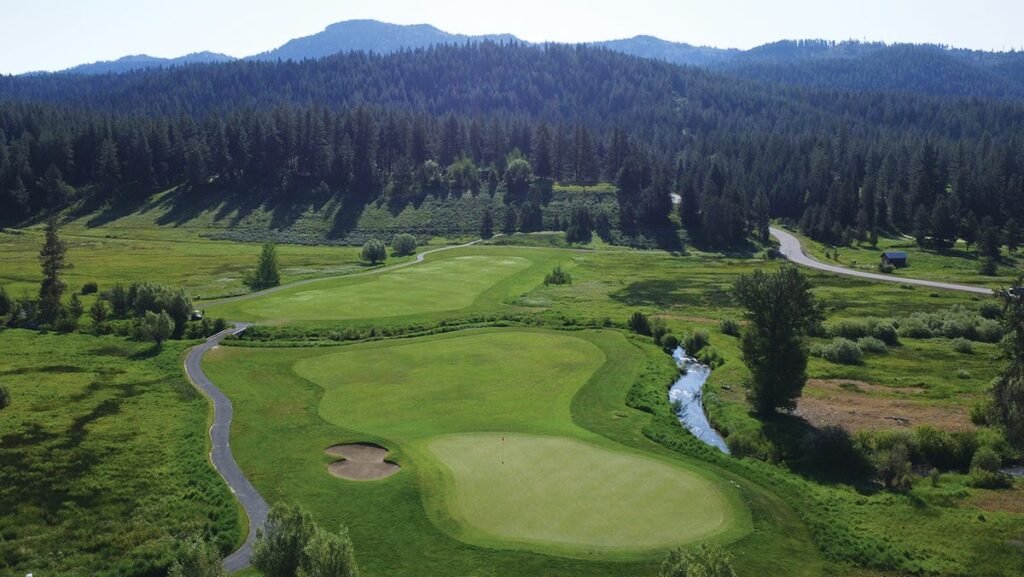Golf in Western Idaho
Golfweek’s raters take in the stunning views and solid golf of western Idaho.
It snowed the night before. Just a light dusting by local standards, but enough to fill the streams with frigid runoff alongside green fairways. It was late June as I stood there in my shorts and short-sleeve golf shirt, applying a second coating of sunscreen and peering at the ski slopes, totally in awe of the mountains and incredibly vertical scenery.
Nearly 3,000 feet above, it had been a winter night atop West Mountain. Down below but less than three miles away, it was summer along the shores of Lake Cascade. Such is Idaho.
I was there to host a group of 24 Golfweek’s Best course raters on a tour of golf courses in Western Idaho. We started in Boise and drove some 100 miles north to our base camp at Tamarack Resort. Those two hours in the car were an introduction to the sensory overload the flatlanders on this trip would experience. Highway 55 constantly twists and turns beneath the bases of nearly vertical walls above the Payette River’s boulder-strewn, Class V rapids – one of the best drives in the country for those so inclined.
The astonishment continued on the golf courses, from which it was impossible to judge distances across the landscape. Is that mountain peak 10 miles away, or 20? Maybe 50? And is that really snow up there? Yes, we were told, and fresh snow at that. Forget the old saw about keeping one’s head down, because golf in this stretch of the Potato State is played with one’s noggin on a swivel.
Golf is far from the only activity in this area. Tamarack Resort boasts that it’s the only ski, golf and lake resort in the country, and its slopes drop at an alarming pace (at least to this Floridian) through the forested mountain slopes. I’ll stick to the golf, I thought, after asking a cart attendant if people really did slide down those hills with nothing more than long skinny boards attached to their feet. That driver off the deck I attempted on the par-5 third hole didn’t seem nearly so daring when considering the winter sports available above the course.
This trip was booked to include three courses: The Club at SpurWing, Jug Mountain Ranch and Osprey Meadows at Tamarack Resort. Because I was leading a rating crew of golf junkies, we added the private Whitetail Club on the fly, thanks to a gracious staff that welcomed us through the gates with open arms.
The Club at SpurWing
Location: Meridian (just northwest of Boise)
Architect: Myron Tucker
Year opened: 1994
Our trip started at the private SpurWing, which was acquired by Concert Golf Partners in early 2025. The course is cleaved by a well-defined canal that empties into the nearby Boise River, with the opening five holes playing through a country club neighborhood on a higher plateau before the scenic par-3 sixth dives off the ridge to the next 11 holes below. No. 18 regains the higher ground as it returns to the clubhouse.
Aside from that downhill sixth, most of SpurWing plays across flat terrain with the Boise Mountains in the distance. The lower portion of Nos. 7 through 17 features frequent water hazards, some hidden off the tee. The greens are generally flat, and course conditioning is the star of the show. Longtime general manager Jason Bideganeta and director of agronomy Ryan Meredith have overseen renovations in recent years that have tweaked the 7,300-yard course and improved irrigation, and the result was incredibly smooth putting surfaces for our round.
The Club at SpurWing is also home to a creative par-3 Challenge Course designed by Steve Pate and Damian Pascuzzo, and several raters raved about it over dinner that night. The nine-hole Challenge Course features two sets of tees, one stretching the layout to 1,284 yards and the other at 887. Each green also features two holes that offer differing shot demands when combined with the various tees, and the greens on the par-3 course are much more dramatic than those of the main 18. If you get the chance to play SpurWing, make sure to make time to tackle the Challenge Course.
Jug Mountain Ranch
Location: The side of a mountain 10 miles from McCall
Designer: Don Knott
Year opened: 2004
Golfers ask me all the time about hidden gems. I normally respond that there aren’t really many such examples these days, as various course rankings – including Golfweek’s Best – and social media have shown spotlights on so many far-flung courses. Consider Jug Mountain Ranch an exception that proves that rule.
None of us really knew what to expect at Jug Mountain, but from the first tee that launches players off a high ridge to the 18th green climbing back into the trees, Jug Mountain thrilled with solid hole after solid hole. That first tee shot drops some 80 feet to a fairway cut off by a beautiful little creek, forcing players to carefully consider club selection from the opening bell.
From there, much of the front nine plays across more open ground to the northwest of the elevated clubhouse before the back nine scampers into and out of tall trees farther south. It’s a masterful routing that takes great advantage of all the terrain offers without ever being too steep. Expect to hit every club in your bag. Holes turn left, right, up and down without ever forcing any kind of repetition into the routing.
The course is part of a still-in-development Jug Mountain Ranch residential community that promises to preserve 1,000 of its total 1,410 acres that abut state land not too far from the incredibly named Frank Church River of No Return Wilderness. The views are stunning from the course, but the fun layout is all just a part of a much larger picture.
Whitetail Club
Location: McCall
Architects: Roger Packard and Andy North
Year opened: 2002
Whitetail was a bonus round for most of our raters, with the course not on our original itinerary. A connection was made between two old high school friends that allowed us access to the course Golfweek’s Best ranks as the No. 3 private layout in Idaho.
This is the type of club that pampers its membership and packs in seasonal activities ranging from boating to cross-country skiing. The club is built within a high-end community with houses costing into the tens of millions, and the golf course is likewise pampered and in immaculate condition.
The golf holes meander across lightly rolling terrain, with some playing through tree lines while others traverse wetlands or prairies. The closing stretch, in particular, takes advantage of open terrain with water in play on Nos. 15-18. The mountains are in view, but the course doesn’t play as a mountain course. The architecture is pure parkland with restrained bunkering and a focus on playability.
Packard and North don’t hit players over the head with extraneous shaping, instead providing a great setting to take in the views and enjoy a round. Their biggest risk comes on No. 4, which plays as a long par 4 to one green to the left across a creek and as a risk-reward par 5 to another green to the right across a pond. The hole alternates greens, and the raters couldn’t decide as a group which they preferred. Either way, this hole asks the most questions of players and their shotmaking of any on the course.
Tamarack Resort’s Osprey Meadows
Location: Tamarack
Architect: Robert Trent Jones Jr.
Year opened: 2005
Osprey Meadows opened to high regard, but economic problems forced its closure in 2015. The course was purchased by Tamarack Resort in 2021 and revived by Jones’ design firm and Landscapes Unlimited. The layout reopened in 2024.
Jones associate Bruce Charlton oversaw much of the work to the course with a focus on playability, and a bonus par-3 19th hole named The Gambler was introduced. On the main 18, forced carries were erased or reduced, fairways were widened and some holes were rerouted.
Beginning in a meadow before moving to steeper, tree-lined corridors for many of the middle holes, the layout packs in plenty of fun shots. The front nine features three par 3s, three par 4s and three par 5s as it moves into the trees – you won’t see a par 4 until No. 5. The routing varies from wide-open in spots to incredibly tight among ponderosa pines in others. The 16th can be a par 4 or a par 5, depending on tee box played, giving the layout a variable par of 72 or 73.
The course raters had a blast playing the variety of holes, all packed tight to a steep mountain slope – most of the raters rushed back out to race around a second time before dinner, and there is no greater commendation for a course than wanting to play it a second time.
And Tamarack isn’t just about golf. Skiing is the main attraction for half the year, the slopes carving through thick forests above the course. My upscale rental condominium featured dryers for snow boots, tipping off the preferred activity for many guests. Our condos wrapped around a village of varied restaurants, bars and shops that cater to a ski-in crowd. Down below, the 47-square-mile Cascade Lake offers a whole other world of recreational and fishing opportunities.
Playing Osprey Meadows, it’s hard to decide where to stare next, west to the mountains or east to the lake. The best part: At Tamarack, you don’t really need to decide. Adjust your vantage or the timing of your visit, and there’s something new and inspiring to see in all directions.
Read the full article here













